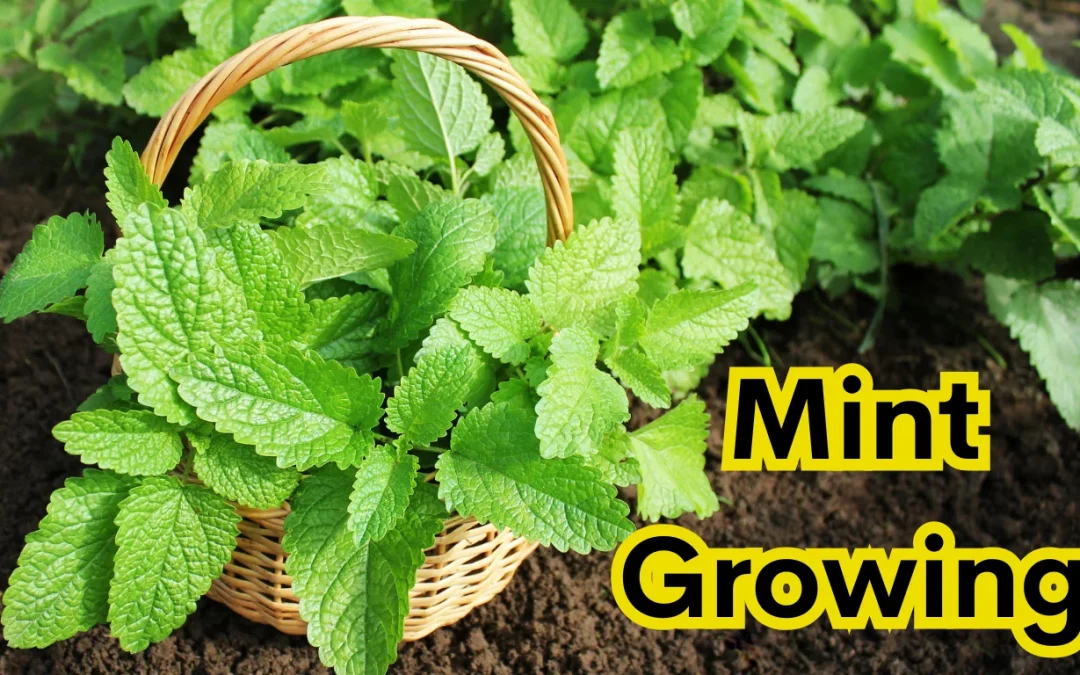Imagine always having fresh, fragrant mint leaves ready. Growing mint indoors is easy and rewarding. You can have a thriving mint plant at home, perfect for teas, cocktails, and cooking.
A vibrant indoor scene showcasing a small mint plant thriving in a terracotta pot on a sunlit windowsill, surrounded by other houseplants and kitchen herbs, soft natural lighting filtering through sheer curtains, earthy tones and fresh green colors, emphasizing growth and freshness.
Indoor mint gardens are beautiful and practical. They give you fresh herbs all the time. Plus, growing your own mint is a fun and calming activity that brings nature indoors.
In this article, we’ll show you how to grow mint indoors. We’ll cover choosing the right mint, preparing your space, planting, watering, fertilizing, and harvesting. You’ll learn to grow a strong and productive mint plant indoors. Let’s start and enjoy fresh mint all year!
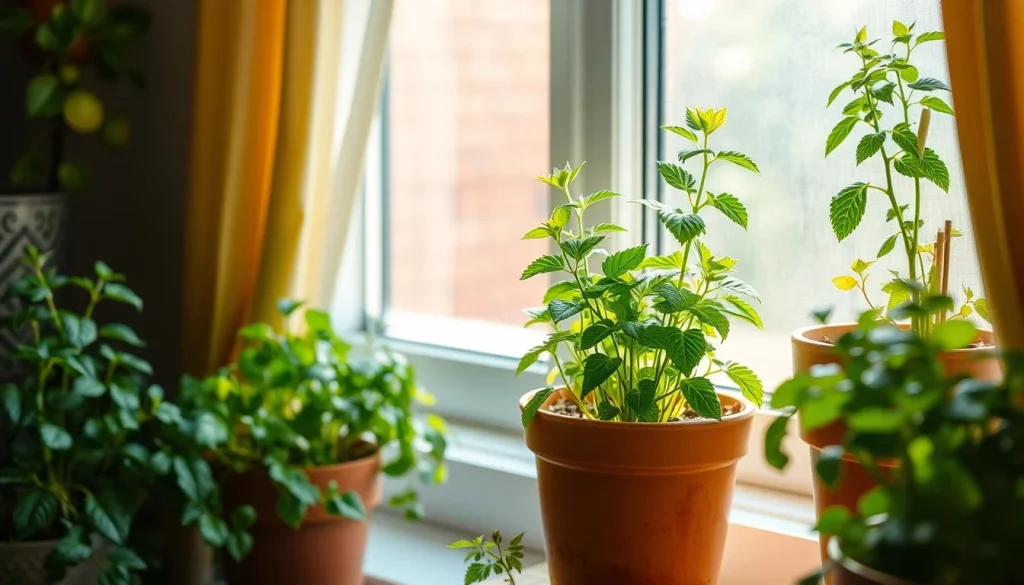
Key Takeaways
- Growing mint indoors provides a convenient, year-round supply of fresh herbs
- Indoor mint gardens offer aesthetic appeal and practicality
- Proper variety selection, growing environment, and care are essential for success
- Nurturing your own mint plant can be a therapeutic and rewarding experience
- This article will guide you through the steps to grow a thriving indoor mint plant
Table of Contents
Why Grow Mint Indoors?
Growing mint indoors is great for those who love herbs and cooking. It lets you have fresh mint all year, no matter the weather. Here’s why it’s a smart move.
Convenience and Accessibility
One big plus of indoor mint is how easy it is to use. Just grab a few leaves for your recipes, tea, or drinks. No need for grocery runs or dried mint anymore. Fresh mint is always at your fingertips.
Fresh Mint Year-Round
Indoor mint means you can enjoy fresh mint all year. Unlike outdoor gardens, you control the environment. So, you can have mint even in winter. Imagine sipping mint tea in winter – it’s a treat!
Mint is also good for you. It helps with digestion, freshens breath, and can ease headaches and stress. Growing it indoors makes it easy to add to your daily life.
Choosing the Right Mint Variety for Indoor Growing
Starting growing mint indoors means picking the right type is key. There are many mints, each with its own taste and growth style. It’s important to pick one that you like and does well indoors.
- Peppermint: It’s famous for its strong scent and cool taste. Its leaves are great for flavoring drinks and desserts.
- Spearmint: It tastes milder and sweeter than peppermint. Its leaves are perfect for garnishing drinks and salads.
- Chocolate Mint: It has a chocolate flavor mixed with mint. It’s a favorite for adding a twist to drinks and baked goods.
When choosing a mint for indoors, think about these things:
| Variety | Flavor Profile | Growth Habit | Uses |
|---|---|---|---|
| Peppermint | Strong, cool, tingling | Vigorous, spreading | Teas, desserts, aromatherapy |
| Spearmint | Mild, sweet, refreshing | Compact, upright | Garnishes, salads, savory dishes |
| Chocolate Mint | Subtle chocolate, minty | Moderate, spreading | Beverages, baked goods, ice cream |
“The best mint variety for indoor growth depends on your personal preferences and the intended use of the herb.” – Indoor Gardening Expert
Choosing the right mint for indoors is all about taste and space. Pick a mint that you enjoy and fits your indoor garden. This way, you’ll have fresh mint all year.
Preparing the Perfect Growing Environment
When growing mint indoors, it’s key to create the best environment for your plant. Pick the right container, use the best soil, and make sure it gets enough light. This will help your indoor mint plant thrive.
Selecting the Right Container
Choose a container that’s at least 8 inches deep and wide. This size is good for your mint plant’s roots. Make sure the pot has holes for water to drain out to avoid root rot. Terracotta or ceramic pots are great for growing mint indoor because they let excess moisture evaporate.
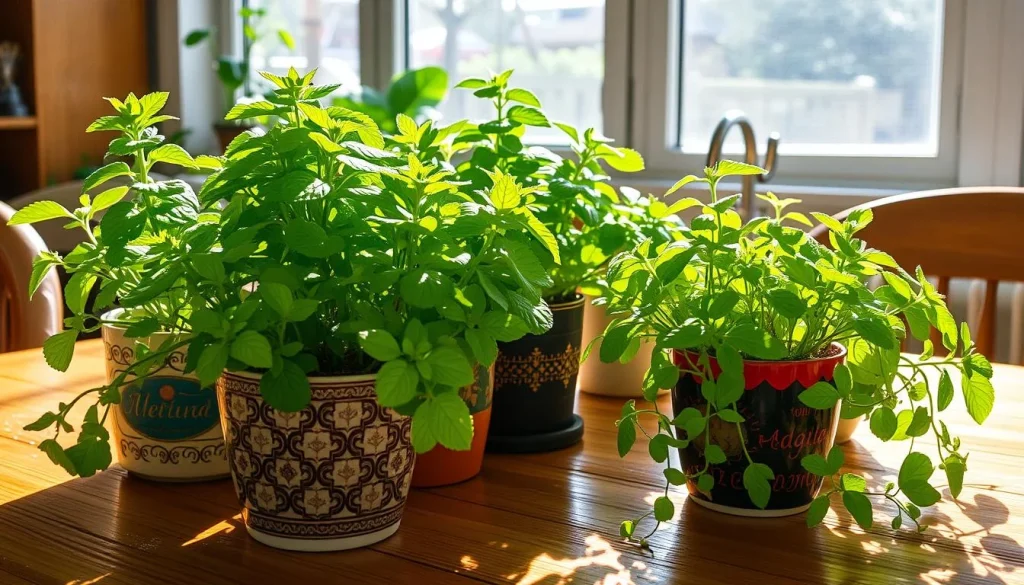
Lush indoor garden featuring vibrant green mint plants in decorative pots, sunlight streaming through a window, soft shadows on a wooden table, rich soil revealing healthy roots, fresh herbs with dew drops glistening, cozy home atmosphere.
Optimal Soil Composition
Mint loves soil that drains well and is full of nutrients. Mix equal parts potting soil, perlite, and compost or aged manure. This mix keeps the soil moist but drains excess water. It also gives your grow mint plant indoors the nutrients it needs.
“A good soil mix is the foundation for healthy plant growth, especially when growing herbs indoors.”
Lighting Requirements
Mint plants need lots of bright, indirect light to grow well indoors. Put your container near a sunny window that gets at least 6 hours of natural light a day. If your home doesn’t get enough natural light, use grow lights to help your mint plant.
By focusing on these three important areas – container selection, soil mix, and light – you’ll make the perfect spot for growing mint indoors successfully.
Get more information about Growing Crops:
- ????Grass Seed to Growing
- ????Growing Eucalyptus
- ????Garlic Growing
- ????Winter Garden Plant
- ????Echinacea Growing
Planting Your Mint Indoors
Now that you’ve set up the perfect spot for your indoor mint, it’s time to plant it. You can grow mint indoors from seeds or by using cuttings or transplants. Here’s how to do it:
Starting from Seeds
Starting mint from seeds is rewarding. It lets you see the whole growth process. To plant mint seeds:
- Fill a seed tray or small pots with well-draining potting mix
- Sprinkle the mint seeds on top of the soil and lightly cover with a thin layer of soil
- Mist the soil surface to moisten it without disturbing the seeds
- Place the tray or pots in a warm, bright location out of direct sunlight
- Keep the soil moist but not soggy as the seeds germinate, which usually takes 10-15 days
- Once the seedlings have a few sets of true leaves, transplant them to their permanent container
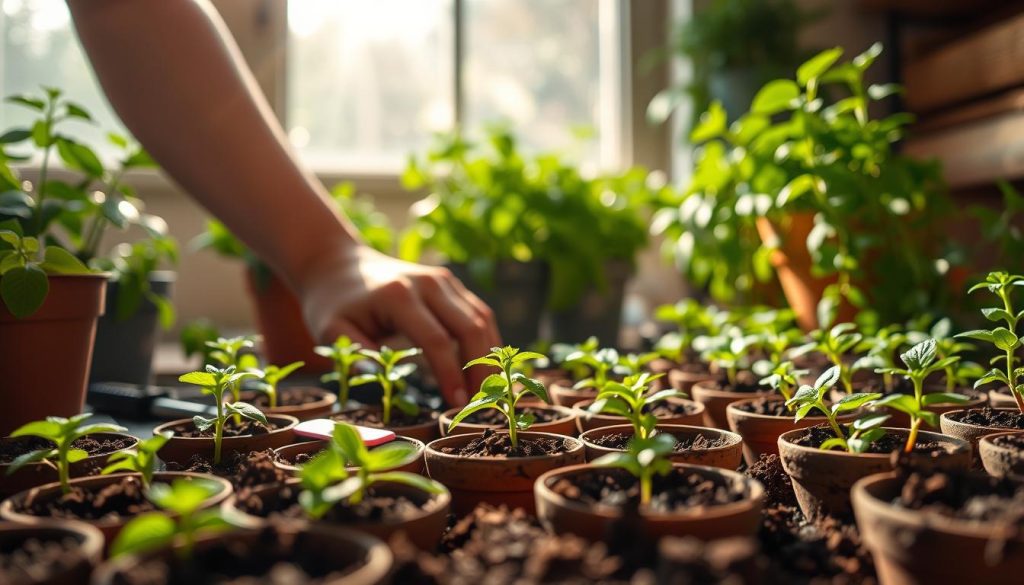
A cozy indoor gardening scene featuring a person planting mint seeds in small pots, surrounded by fresh soil, twinkling sunlight streaming through a window, and lush green herbs in the background. The atmosphere should feel warm and inviting, highlighting the vibrant colors of the mint seeds and the earthy tones of the potting soil.
Using Cuttings or Transplants
For a quicker start, use cuttings or transplants from an existing mint plant:
- For cuttings, snip a 4-inch section of stem just below a node and remove the lower leaves. Place the cutting in water or moist potting mix until roots form, then transplant to a container.
- For transplants, carefully remove a section of an established mint plant, keeping the roots intact. Plant it in your prepared container at the same depth it was previously growing.
When planting your mint, whether from seeds, cuttings, or transplants, follow this spacing guide for optimal growth:
| Container Size | Number of Plants |
|---|---|
| 6-inch pot | 1 |
| 8-inch pot | 2-3 |
| 12-inch pot | 4-5 |
“The key to successfully growing mint indoors is providing the right conditions from the start. With proper planting techniques and care, you’ll be enjoying fresh mint leaves year-round.”
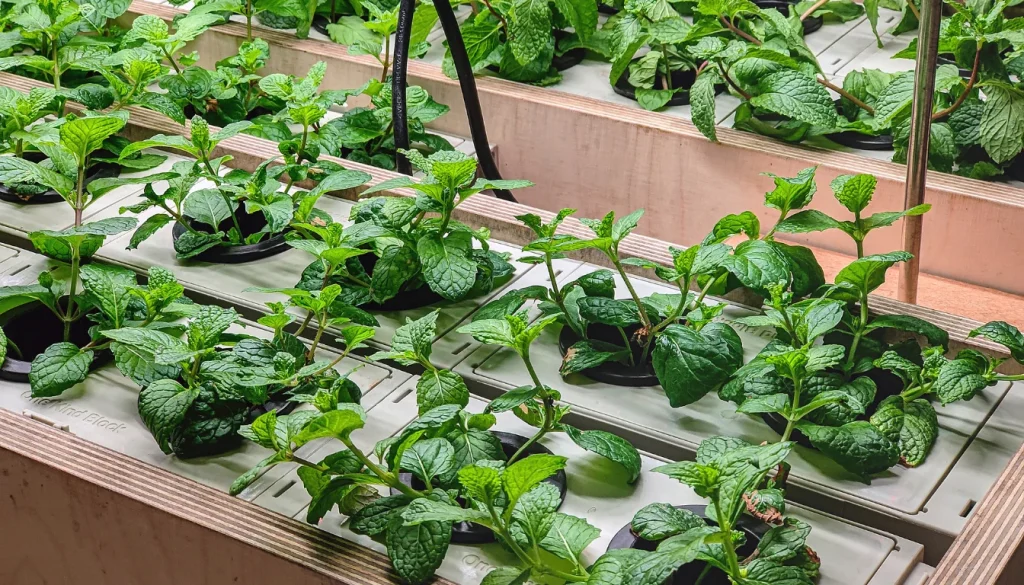
After planting, water your mint well and place it in a bright, warm location. With the right growing environment and care, your indoor mint plant will thrive. You’ll have a constant supply of fresh, flavorful leaves.
Watering and Humidity for Indoor Mint Plants
When growing mint indoors, it’s key to get watering and humidity right. Mint likes moist soil but too much water can harm it. This can cause root rot and other problems.
To water your mint right, check the soil daily. Stick your finger in about an inch deep. If it’s dry, it’s time to water. Water until the soil is moist but not too wet. Here’s a basic watering guide for indoor mint:
| Season | Watering Frequency |
|---|---|
| Spring/Summer | Every 2-3 days |
| Fall/Winter | Every 4-5 days |
Mint also likes a bit more humidity. You can boost humidity by using a water tray, misting leaves, or a humidifier. Aim for 50-60% humidity for best growth.
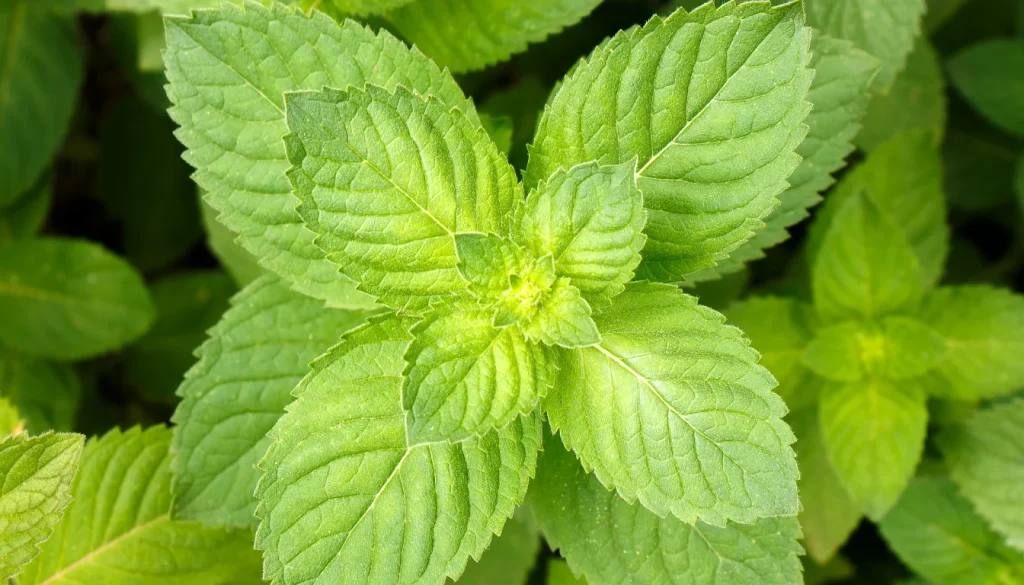
A cozy indoor garden scene featuring vibrant green mint plants in pots, set on a sunlit windowsill. The scene includes a small watering can, droplets of water glistening on the leaves, and gentle humidity in the air with soft light filtering through sheer curtains. A few mint sprigs are freshly cut and placed nearby, emphasizing the freshness of the herbs.
If your mint’s leaves start to droop, it might be thirsty. But if they turn yellow or the soil is too wet, you’re watering too much. Adjust your watering to keep your mint happy and healthy.
The key to successfully growing mint indoors is finding the right balance of moisture and humidity.
By watching your plant’s needs and adjusting your care, you can enjoy fresh mint all year. Even indoors, you can grow your own mint.
Fertilizing Your Indoor Mint Plant
When growing a mint plant indoors, it’s key to give it the right nutrients. This helps it grow well and gives you lots of leaves. Since indoor mint plants have small soil spaces, they need regular food to stay healthy.
Choosing the Right Fertilizer
Choose a balanced, water-soluble fertilizer made for herbs or indoor plants. Look for one with an NPK ratio of 5-5-5. This means it has equal amounts of nitrogen, phosphorus, and potassium. Organic options like fish emulsion or seaweed extract are good too.
Frequency and Amount of Fertilization
Fertilize your indoor mint plant every 4-6 weeks when it’s growing fast. Change how often you fertilize based on how fast it grows and the fertilizer’s strength. Always follow the instructions on the fertilizer to avoid harming your plant.
Here’s a simple guide for fertilizing your indoor mint plant:
| Plant Size | Fertilizer Dilution | Frequency |
|---|---|---|
| Small (4″ pot) | 1/4 strength | Every 6 weeks |
| Medium (6″ pot) | 1/2 strength | Every 4-6 weeks |
| Large (8″ pot or larger) | Full strength | Every 4 weeks |
When growing mint indoors, it’s safer to fertilize less than too much. Too much fertilizer can harm the roots. By fertilizing right, your mint plant will stay healthy and keep giving you tasty leaves all year.
Pruning and Harvesting Your Mint
To keep your growing mint plant indoors healthy, regular pruning and harvesting are key. Pruning keeps the plant’s shape and encourages fuller growth. It also stops it from becoming leggy or sparse. Harvesting lets you enjoy fresh mint leaves all year without harming the plant.
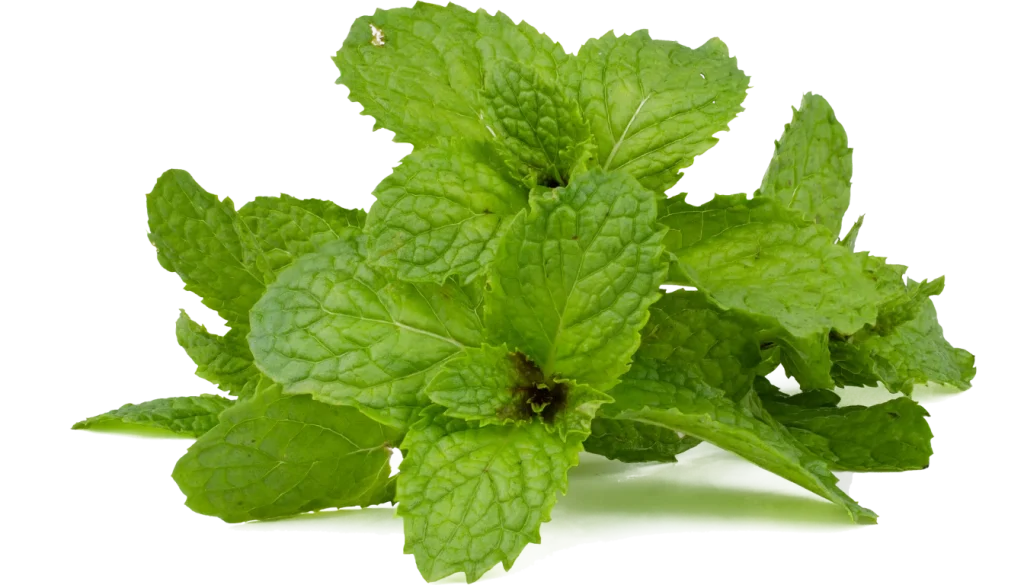
Regular Pruning for Optimal Growth
Pruning is crucial when growing mint leaves indoors. Here’s how to prune your mint plant:
- Remove any dead, damaged, or yellowing leaves.
- Pinch off the tips of the stems to encourage bushier growth.
- Cut back the stems by about one-third their length every few weeks.
- After flowering, cut the stems back to the first or second set of leaves to promote new growth.
Regular pruning keeps your indoor mint plant looking neat. It also encourages new leaves to grow, giving you a steady supply of fresh mint.
Harvesting Techniques
When learning how to grow mint indoors, it’s important to harvest correctly. This way, you can enjoy fresh mint leaves without harming the plant. Here’s how to harvest your indoor mint:
- Harvest mint leaves as needed, selecting the oldest leaves first.
- Pinch off individual leaves or cut stems just above a pair of leaves.
- Avoid removing more than one-third of the plant’s leaves at a time.
- Let the plant recover between harvests, ensuring enough leaves for photosynthesis.
The table below summarizes the key points for pruning and harvesting your indoor mint plant:
| Pruning | Harvesting |
|---|---|
| Remove dead, damaged, or yellowing leaves | Harvest the oldest leaves first |
| Pinch off stem tips for bushier growth | Pinch off individual leaves or cut stems above leaf pairs |
| Cut stems back by one-third every few weeks | Don’t remove more than one-third of leaves at once |
| Cut stems back to first or second leaf set after flowering | Allow plant to recover between harvests |
“The art of harvesting mint lies in finding the perfect balance between enjoying the fresh leaves and allowing the plant to thrive.”
By following these pruning and harvesting techniques, you’ll have a healthy, productive mint plant. It will provide you with fresh, flavorful leaves for all your culinary and aromatic needs.
Conclusion
Growing mint indoors is easy and fun. It lets you enjoy fresh herbs all year. Just follow the steps in this article to grow your own mint garden.
Choosing the right mint variety and setting up the best growing space are key. Then, plant, water, fertilize, and harvest your mint. It’s simple and works for all gardeners.
Growing mint indoors has many perks. You’ll always have fresh mint for cooking, drinks, and decorating. Plus, your home will smell amazing from the mint.
Starting to grow mint indoors opens up new cooking adventures. It also brings joy from watching your herbs grow. So, begin your mint-growing journey today. Soon, you’ll enjoy the fresh taste of your mint in every meal.
FAQ
What are the benefits of growing mint indoors?
Growing mint indoors is convenient and always available. You can pick fresh mint leaves anytime for cooking or health. This way, you don’t have to wait for outdoor weather.
Which mint varieties are best suited for indoor growth?
Peppermint and spearmint are top picks for indoor mint. They each have special tastes and looks. Pick the one that fits your taste best.
What type of container should I use for growing mint indoors?
Choose a container with holes for drainage and the right size for your mint. Pots made of plastic, ceramic, or terracotta work well. Make sure it’s at least 8 inches deep for the roots.
How do I start growing mint indoors?
You can start with seeds or cuttings. For seeds, just plant them in the soil. For cuttings, take a stem from a healthy mint plant, soak it in water until roots grow, then plant it in soil.
How often should I water my indoor mint plant?
Keep the soil moist but not too wet. Water when the top inch of soil feels dry. Make sure the soil drains well to avoid root rot.
What kind of fertilizer should I use for my indoor mint plant?
Use a balanced fertilizer made for herbs or indoor plants. Follow the instructions for how much to use and how often. Don’t overdo it, as too much can harm the plant’s taste.
How do I prune and harvest my indoor mint plant?
Pruning keeps your mint looking good and healthy. Cut off the top leaves and stems to make it bushier. When harvesting, take only a third of the plant at a time to avoid harming it.

